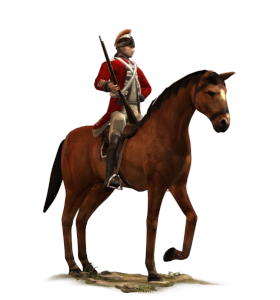Difference between revisions of "Light Dragoons (ETW Unit)"
Tango12345 (talk | contribs) m |
|||
| Line 20: | Line 20: | ||
*[[Great Britain (ETW Faction)|Great Britain]] | *[[Great Britain (ETW Faction)|Great Britain]] | ||
| − | [[Category: | + | [[Category:Empire Total War Units]] |
| + | [[Category:ETW Cavalry]] | ||
Revision as of 15:35, 6 August 2011
Game Description
Their horses are for mobility, not for any shock value in battle and are often little better than nags and ponies, rather than decent warhorses. In battle, this is unimportant as light dragoons dismount and form a skirmish line to harass an enemy and screen the main body of their own army.
The main weapon carried is a shortened musket, originally termed a “dragon” or dragoon (like “rifle”, the term came to be applied to the man carrying the gun). This is not an accurate weapon, but is no worse than any other smooth-bore.
Light dragoons are also useful in suppressing riotous and rebellious civilians. Their horses give them strategic mobility, allowing them to police large areas effectively and come to the aid of the local authorities.
Historically, dragoons lost their role as mounted infantry over the course of the 18th Century, and became another kind of light cavalry, although they retained the name. The officers and men welcomed the change to a role that had a higher social status (and usually better
Overview
Dragoons are ranged cavalry. They may engage effectively in both firefights and melee, although they are not as strong as specialized units in either area. Dragoons have the options to skirmish, where they will attempt to harrass the enemy while staying out of range, and dismount. Dismounting dragoons reduces their speed and melee capabilities, but improves their resistance to enemy fire. Versatile in their uses, dragoons can be used to add firepower support to a point on the battlefield quickly and are equally useful in the conventional cavalry roles of breaking enemy morale and chasing down routing troops.
On top of all this, dragooons recieve bonuses in repression of local populations, and are a useful addition to militia forces in areas of unrest as a peacekeeping force.
